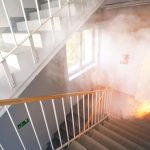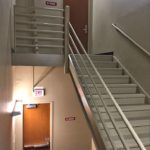 The 2024 code development cycle is well under way, and some changes to the 2024 International Building Code (IBC) affecting doors and hardware have already been approved. While some of these changes will not apply until the 2024 code is adopted in a project’s jurisdiction, others are clarifications that may be used right way to help with more consistent interpretations of the requirements.
The 2024 code development cycle is well under way, and some changes to the 2024 International Building Code (IBC) affecting doors and hardware have already been approved. While some of these changes will not apply until the 2024 code is adopted in a project’s jurisdiction, others are clarifications that may be used right way to help with more consistent interpretations of the requirements.
Two of the approved changes affect the locking of stairwell doors; ICC Proposals E47-21 and G61-21 were approved as modified by floor modifications during the committee action hearings.
The IBC currently requires all doors leading to a stairwell to allow building occupants to leave the stairwell if it should become compromised during a fire by smoke and flames or by firefighters and equipment. To facilitate stairwell reentry, doors may have passage sets or fire exit hardware with non-locking lever trim (no lock on either side of the door), or doors may have electrified locks or electrified lever trim for fire exit hardware on the stairwell side. During a fire, the electrified lever on the stair side of the door is intended to be unlocked remotely without unlatching, allowing building occupants to open the door from within the stairwell to find another exit or wait for assistance.
In the 2021 and prior editions of the IBC, electrically-locked stairwell doors are required to be unlocked by a switch located at the fire command center or inside the main entrance of the building. But what if the fire department has not yet arrived to activate the switch? And what happens to the locks if there is a loss of power? For this application, the hardware industry typically uses fail safe locks which automatically release upon loss of power, but this was not specifically mandated by past editions of the code.
This will be resolved in the 2024 IBC, where locks on the stair side of stairwell doors must be capable of being unlocked simultaneously without unlatching, when any of the following conditions occur:
- A signal from the fire command center, if present, or a signal by emergency personnel from a single location inside the building’s main entrance
- Activation of a fire alarm signal (where present) in an area served by the stairwell
- Power failure to the electric lock or locking system
This change will ensure the highest level of safety with regard to stairwell reentry and will be consistent with what has already been an industry best practice. In addition, it will align the fire alarm release requirement of the IBC with that of NFPA 101 – Life Safety Code. While NFPA 101 requires these locks to be unlocked upon activation of the fire alarm system, prior editions of the IBC did not reference fire alarm activation in this section and relied on the switch at the fire command center to be activated by fire department personnel.
More information about the current ICC code development cycle can be found here.
You need to login or register to bookmark/favorite this content.







Leave A Comment